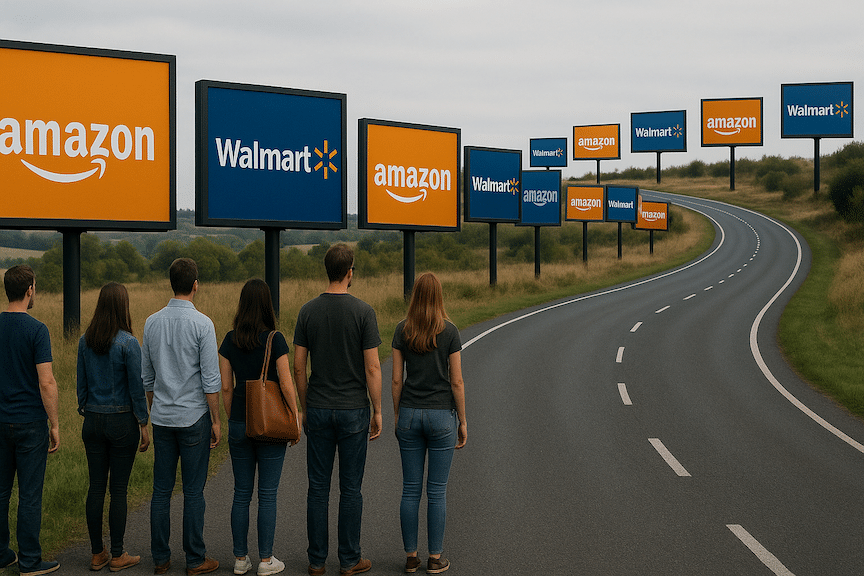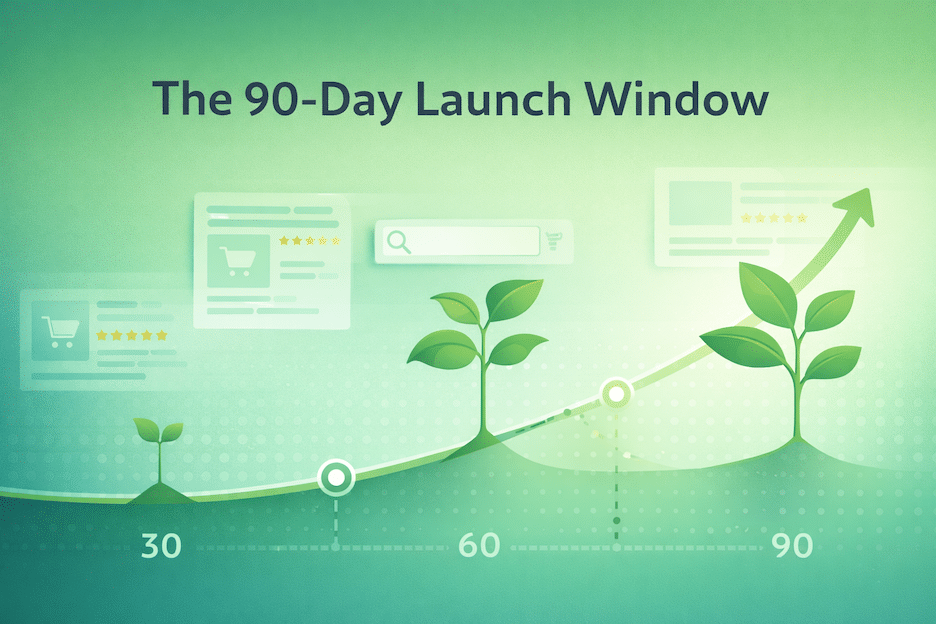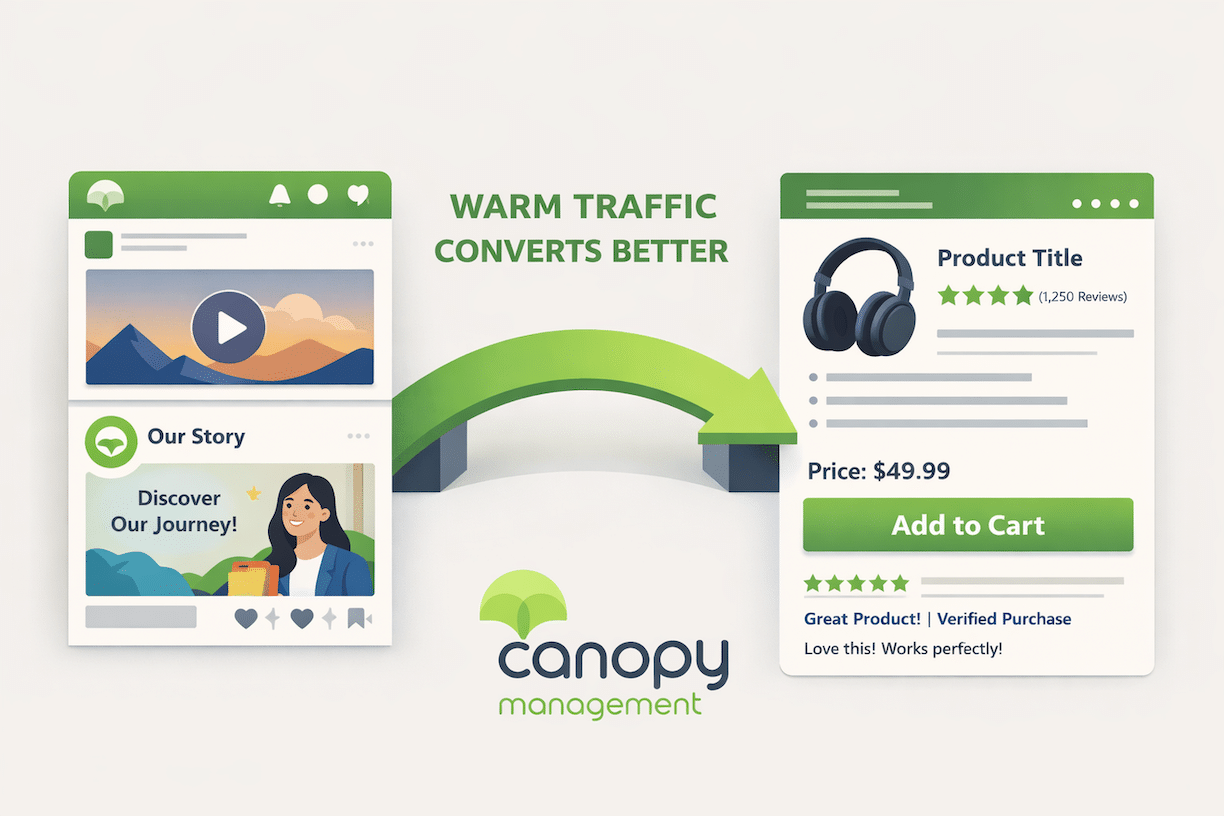Walmart vs Amazon PPC Strategy Guide for Multi-Platform Sellers
Multi-platform sellers need different strategies for each ecosystem – here’s what’s changed and what you need to do about it

Selling on both Amazon and Walmart?
Smart move – diversification protects your business and opens new revenue streams. But if you’re copying the same PPC campaigns between platforms, you’re leaving serious money on the table.
Amazon and Walmart advertising has hit a tipping point. The playbook that worked six months ago? It’s dead.
Why the Same Strategy Won’t Work on Both Platforms
Selling on both Amazon and Walmart represents smart diversification, but copying identical PPC campaigns between platforms leaves significant revenue unrealized. Based on current marketplace dynamics, each platform now requires specialized approaches aligned with their unique strengths.
What’s Changed
After analyzing advertising performance across both platforms, three critical changes have reshaped the competitive landscape:
- Amazon’s AI automation has shifted control from manual bidding to algorithm optimization
- Walmart’s omnichannel data integration enables targeting impossible on other platforms
- Cost disparities have widened, with Walmart CPCs running approximately 30% lower than Amazon
Ready to Start Growing Your Amazon Brand?
Canopy’s Partners Achieve an Average 84% Profit Increase!
Find out moreAmazon’s AI Advertising Shift
Key Amazon Updates (2024-2025)
Amazon has systematically automated previously manual processes, fundamentally altering how successful campaigns operate:
AI Video Builder: Launched in beta September 2024 and made widely available to all U.S. advertisers in June 2025, this tool creates product videos from single images. Performance data indicates video ads consistently outperform static alternatives, with sponsored brand campaigns featuring video elements seeing 30% higher click-through rates on average.
Agentic AI Creative Studio: Announced in September 2025, Amazon’s new conversational AI tool within Creative Studio acts as a full creative partner. Advertisers can chat with the AI to conduct product and audience research, brainstorm concepts, develop storyboards, and produce campaign-ready video and display ads – all through natural conversation with no design skills required. This democratizes sophisticated creative development that previously required tens of thousands of dollars and weeks of production time.
Dynamic Headlines: Amazon’s system now automatically adapts ad headlines based on individual shopper search queries, moving beyond simple keyword matching toward contextual relevance.
Rufus Integration: Amazon’s AI shopping assistant became available to all U.S. customers in September 2024, changing product discovery from keyword-based searches to conversational queries. This shift impacts how products get found and which keywords drive visibility.
Extended Data Access: Amazon Marketing Cloud now offers a five-year lookback window for retail purchase signals, announced at CES 2025 and available as a paid AMC feature. This dramatically improves customer lifetime value analysis for brands with longer purchase cycles – particularly durable goods, seasonal products, and items with multi-year replacement patterns. Additionally, AMC expanded its ad traffic lookback to 25 months in November 2025, enabling complete year-over-year performance analysis.
How to Adapt on Amazon
Successful Amazon advertising in 2025 requires three fundamental shifts:
1. Foundation-First Approach
Amazon’s AI systems require high-quality input data to perform effectively. This means:
- Comprehensive A+ Content with detailed product information
- Professional product photography optimized for AI video generation
- Complete product attribute data to support algorithm decision-making
2. Build for Long-Term Value
With five-year purchase data now available through AMC, focus shifts from short-term ACOS optimization to customer lifetime value maximization:
- Segment campaigns by customer acquisition vs. retention objectives
- Use AMC data to identify high-value customer patterns
- Optimize for Amazon’s Long-Term Sales ROAS metrics rather than traditional ACOS
3. Separate Discovery, Research, and Performance
AI algorithms perform better with clear performance signals:
- Discovery campaigns: Auto and broad match for new keyword identification
- Research campaigns: Phrase match for qualified traffic
- Performance campaigns: Exact match for proven converting terms
- Hero campaigns: Single-keyword campaigns for your most valuable terms
Video Ads Are Now Essential
Amazon’s AI Video Generator helps brands create engaging video content from a single product image in minutes at no additional cost. Early adoption provides competitive advantages:
- Immediate implementation: Use Amazon’s free video generation tools
- Test systematically: Compare video vs. static ad performance
- Scale successful formats: Apply learnings across your product catalog

Walmart’s Omnichannel Advantage
What Makes Walmart Targeting Different
90% of Americans within 10 miles of a Walmart store – and now they’re expanding their “dark store” concept. That’s the biggest reason why Walmart’s unparalleled omnichannel customer insights surpass anything available to Amazon.
True Omnichannel Targeting: When targeting “new parents” on Walmart Connect, campaigns leverage customers who purchase diapers in-store weekly while browsing car seats online—creating precision targeting that feels like mind-reading.
Real-Time Competitive Intelligence: Walmart’s system can automatically increase competitor keyword bids when their products go out-of-stock in key store locations, capitalizing on immediate brand-switching opportunities.
Brand Term Conquesting: Walmart’s brand term targeting, introduced in early 2024, allows advertisers to bid on competitors’ branded keywords while leveraging omnichannel purchase data for optimization. This “conquesting” capability helps brands reach high-intent shoppers actively searching for competitors, and data shows 54% of Walmart shoppers are open to switching brands.
Walmart’s Lower CPCs
Walmart CPCs typically range from $0.35-$0.75 compared to Amazon’s $0.85-$1.20 range, providing several strategic opportunities:
- Aggressive market share capture: Lower costs enable more competitive bidding
- Extended testing periods: Affordable CPCs support longer optimization cycles
- Broader keyword coverage: Budget constraints less limiting than Amazon
Important context: CPCs on both platforms have reached record highs through 2025 as advertiser competition intensifies. Amazon’s costs have climbed gradually but consistently, while Walmart’s rose more sharply as its advertiser base expands. The cost gap between platforms remains significant, but efficiency now depends on precision – automated pacing, refined segmentation, and disciplined budget allocation are essential for staying profitable as every click costs more.
Walmart’s Three-Phase Strategy
Phase 1: Retail Readiness (Foundation)
Before spending advertising dollars, ensure operational excellence:
- Competitive pricing: Essential for winning buy box placement
- Inventory reliability: Consistent stock levels prevent wasted ad spend
- Fast fulfillment: WFS (Walmart Fulfillment Services) offers lower fees than Amazon FBA, particularly for heavier items
Phase 2: Search Foundation Building
- Start with automatic campaigns: Allow Walmart’s algorithm to discover relevant keywords
- Harvest winning keywords: Move successful terms to manual campaigns with tiered bidding
- Build negative keyword lists: Prevent spend on irrelevant traffic
Phase 3: Competitive Positioning
- Defensive strategies: Maintain high in-stock rates and competitive pricing
- Offensive conquesting: Test competitor keywords where you have clear advantages
- Seasonal optimization: Leverage Walmart’s store traffic data for timing
Ready to Grow Your Walmart Business?
Canopy’s Partners Achieve an Average 84% Profit Increase!
Let's talkMetrics That Actually Matter
Traditional ACOS and ROAS reporting provides incomplete pictures of advertising effectiveness. Both platforms now offer metrics aligned with business growth rather than campaign efficiency.
Amazon’s Advanced Metrics
Long-Term Sales ROAS: Projects 12-month revenue impact from current advertising spend, shifting focus from monthly efficiency to future business value. This metric helps advertisers understand whether higher ACOS investments today generate profitable long-term customer relationships.
Customer Lifetime Value Integration: Five-year purchase data enables true lifetime value calculations, particularly valuable for:
- Durable goods with multi-year replacement cycles
- Consumables with predictable repurchase patterns
- Premium products with high switching costs
Walmart’s Omnichannel Attribution
In-Store Purchase Connection: Walmart’s reporting connects online advertising to in-store purchases, revealing the complete customer journey impact. This proves especially valuable for:
- Grocery and household essentials
- Products customers prefer to see before buying
- Items with immediate need fulfillment
Cross-Channel Performance: Track how online advertising influences both digital and physical store sales, providing complete return on ad spend calculations.
Platform Cost Comparison
Understanding platform economics helps determine optimal resource allocation and strategic approach.
Amazon’s Cost Structure
- Higher CPCs: Average $0.80 CPCs require surgical precision in campaign management
- FBA premium: Storage and fulfillment costs reduce profit margins
- Subscription fees: $39.99 monthly professional account requirement
- Massive scale compensation: Five times Walmart’s traffic volume with 61% of Americans starting product searches on Amazon
Walmart’s Cost Structure
- Lower advertising costs: Approximately $0.56 average CPCs
- Reduced fulfillment expenses: WFS fees generally lower than FBA, especially for larger items
- No monthly subscription fees: Immediate cost savings for smaller sellers
- Growing but smaller audience: Fewer competitors but less total traffic
Strategic Resource Allocation
Amazon Approach: Invest in precision—higher costs demand surgical campaign management and proven performance before scaling.
Walmart Approach: Leverage efficiency—lower costs enable broader testing, aggressive market share pursuit, and experimental campaigns.
What’s Coming in 2025-2026
Amazon’s Media Expansion
Amazon advertising is expanding across its media empire:
- Prime Video integration: Video advertising reaching streaming audiences
- Alexa commerce: Voice-activated shopping optimization
- Fire TV advertising: Connected TV advertising opportunities
- Cross-device campaigns: Unified campaigns across Amazon’s entire ecosystem
Walmart’s AI and Automation Plans
Walmart’s AI strategy focuses on omnichannel operation optimization:
- Supply chain automation: Improved inventory management and forecasting
- In-store associate AI: Enhanced customer service and product recommendations
- Fulfillment automation: Reduced shipping times and costs
- Predictive commerce: Anticipatory inventory positioning based on local demand
Implementation Roadmap
For Amazon Success
Week 1-2: Foundation Audit
- Review product listings for A+ Content completeness
- Assess product photography for AI video generation readiness
- Audit current campaign structure for algorithm clarity
Week 3-4: Campaign Restructuring
- Separate discovery, research, and performance campaigns
- Implement single-keyword campaigns for top performers
- Begin video ad testing with AI-generated content
Month 2-3: Advanced Optimization
- Access Amazon Marketing Cloud for extended customer data
- Shift focus from ACOS to Long-Term Sales ROAS optimization
- Build audience segments based on customer lifetime value
For Walmart Success
Week 1-2: Operational Readiness
- Verify competitive pricing across key products
- Assess inventory reliability and fulfillment speed
- Consider WFS enrollment for eligible products
Week 3-4: Campaign Foundation
- Launch automatic campaigns for keyword discovery
- Set conservative initial bids ($0.20 auto, $0.30 manual)
- Build comprehensive negative keyword lists
Month 2-3: Competitive Strategy
- Harvest successful keywords into manual campaigns
- Test competitor brand term targeting
- Develop defensive strategies for key product categories

FAQ: Common Multi-Platform Questions
Can I use the same keywords across Amazon and Walmart?
While product-relevant keywords overlap, bidding strategies, match types, and campaign structures should differ based on each platform’s auction dynamics and competition levels.
Should I prioritize Amazon or Walmart for new product launches?
Amazon offers greater traffic volume for initial market validation, while Walmart provides lower-cost testing environments. Consider launching on Amazon first, then expanding to Walmart with proven products.
How do I measure success across both platforms?
Use platform-native metrics (Amazon’s LTS ROAS, Walmart’s omnichannel attribution) rather than trying to standardize performance measurement. Success looks different on each platform.
What’s the minimum budget needed for each platform?
Amazon typically requires $1,000+ monthly budgets for meaningful data collection, while Walmart’s lower CPCs enable effective testing with $500+ monthly budgets.
Should I use the same fulfillment service for both platforms?
No. Use FBA for Amazon and WFS for Walmart to maximize each platform’s algorithmic preference for their respective fulfillment services.
How long does it take to see meaningful results from Walmart advertising?
Walmart campaigns typically show positive ROAS within the first two weeks when properly optimized. However, allow 4-6 weeks of consistent optimization to identify reliable trends and achieve target performance metrics.
Should I use automatic or manual campaigns on Walmart?
Start with automatic campaigns to let Walmart’s algorithm discover relevant keywords—data shows automatic targeting delivers 1.7x higher ROAS compared to similar manual campaigns. After 4-6 weeks, harvest winning search terms into manual campaigns for more precise control.
Can Walmart advertising drive in-store sales, not just online?
Yes. Walmart Connect’s omnichannel attribution tracks how online ads influence both digital and physical store purchases. This in-store connection is particularly valuable for grocery, household essentials, and products customers prefer to see before buying.
Are CPCs still lower on Walmart, or has the gap closed?
Walmart CPCs remain significantly lower than Amazon’s, though both platforms have seen costs rise through 2025 as competition intensifies. Walmart’s cost advantage persists, but the gap may narrow as more advertisers shift budget to the platform.
The Bottom Line
Platform specialization isn’t optional anymore – it’s the requirement for competitive success. The brands winning in 2025 understand that Amazon and Walmart aren’t just different marketplaces; they’re entirely different ecosystems requiring different strategies, metrics, and definitions of success.
Amazon rewards: Long-term thinking, customer lifetime value optimization, and AI collaboration
Walmart rewards: Operational excellence, omnichannel integration, and competitive market positioning
Both platforms reward excellence, but they define excellence differently. Success comes from respecting those differences instead of fighting them.
The future belongs to brands that master both ecosystems. The question isn’t whether to sell on both platforms – it’s whether you’ll develop platform-specific expertise or continue leaving money on the table with one-size-fits-all approaches.
Ready to partner with a team that has the systems and expertise to scale your brand?
Canopy Management delivers end-to-end eCommerce growth, leading the industry in Amazon marketplace strategy while powering expansion through Shopify, Meta, and Google. Our full-funnel approach — from marketplace optimization to customer acquisition — has generated over $3.3 billion in partner revenue and made us the trusted growth engine for brands worldwide.
Schedule a strategy session with our team to discover exactly how our proven frameworks can accelerate your growth.
Ready to Start Growing Your Amazon Brand?
Canopy’s Partners Achieve an Average 84% Profit Increase!
Find out more

